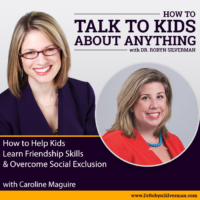Podcast: Play in new window | Download
Subscribe: Apple Podcasts | RSS | More
How to Help Young Kids Cope with Tempers and Tantrums
This podcast focuses on young children and what to do when they experience “feelings overload,” won’t listen or are having a physical tantrum. Dr. Lynne Kenney discusses how to deal with the “I won’ts” and “I can’ts” so that everyone stays more calm and connected even when emotions run hot.
Parenting young children can be tough! They can get overloaded, stuck, frustrated and as we’ve talked about before, they need our help when their limbic brains are on meltdown. So what can you SAY, THINK and DO, to help your children manage their BIG  feelings and learn to do as you ask? Today, we are talking a second time with pediatric Psychologist, Dr. Lynne Kenney, about how to handle the tantrums, the “I won’ts” and “I can’ts”, to help you parent with more collaboration, peace, and calm in your family.
feelings and learn to do as you ask? Today, we are talking a second time with pediatric Psychologist, Dr. Lynne Kenney, about how to handle the tantrums, the “I won’ts” and “I can’ts”, to help you parent with more collaboration, peace, and calm in your family.
Pediatric Psychologist, Dr. Lynne Kenney, Psy.D., is an international educator and author of five books on improving Executive Functions and Social-Emotional Learning in children ages 3-12. Currently, Dr. Kenney is preparing for a 20 city international tour to bring 2-3 minute classroom cognitive-physical activities that engage attention, memory, cognitive flexibility and self-regulation worldwide. Learn more about #TheKineticClassroom at www.lynnekenney.com.
The podcast provides:
- What “feelings overload” means to a child
- How “feelings overload” can lead to tantrums
- Why children resist doing simple things their parents tell them to do
- Why children say they can’t do something when they can
- What to do when your young child won’t do what you’ve asked them to do
- What to do when your child won’t listen and you are running out of time
- What to do with the other children when one of throwing a tantrum
Important Messages:
- If you are faced with a task that exceeded your skill set in that moment, that puts us into stress response—feelings overload.
- Many kids don’t have the skills to deal with a task we are asking them to do at the time and a tantrum ensues. They don’t have the cognitive skills to cope.
- As adults, we see tasks as simple- get in the car, brush our teeth, put on our shoes—but to a young child, they may not be. And they don’t have the language ability to negotiate. Even though getting in the car seems simple, if they want to eat the last piece of French toast or get my blanky, they may not have the language to negotiate and talk about it.
- Standard response is we prepare them for the transition—but this isn’t actually the right response.
- What you need to do—is use the thinker to calm the caveman. The fastest way to do this is to engage the vagal system. For example, sing a song. Use singing, swaying, swaddling and swinging.
- For a resistant child, continue to engage the vagal system- give them choice in song. “We’re stepping in, we’re stepping out- when will we go? Will it be right now?” Continue to engage the vagal system as you move away from the comforts of the house.
- Teach your child to sway- let your child be the teacher and lead you. “Going to school sometimes makes my brain nervous- can you hold my hands and sway with me?” That way the child isn’t always waiting on the parent or teacher to engage the vagal system. Use the parent as the interim object.
- Or you can use questions- not just why—what’s the barrier?
- If they don’t have the cognitive flexibility to go from a preferred activity to a non-preferred activity, that’s when you engage the thinker and get creative.
- Script: “What shirt do you want to wear to school? Well, we are looking at the clock and our friends are waiting for us in about 6 minutes, do you want to start with picking out your shirt or your pants?”
- As soon as you can shift the responsibility, accountability and agency to the kid, do that. Coach them to the next brick on the yellow brick road of development. Push them onto the next brick- and once they are standing on the next brick you’re like ‘awesomesauce!’ I’ve got things to do, you’ve got things to do- meet you in the kitchen in 5 minutes!
- Every moment is different for a child. Your job is to incorporate the skills so that they can be prosocial adults.
- Script: “I think you can do this! You’ve been upstairs before- what’s in the way now? You run up, run down, and how can we show our love together?”
- Ask yourself- what’s the task demand? Does she have the skill set right now? If so, coax her through. If not, turn it into a game- problem solve- and see what piece you can do to help without doing it all.
- You get the task done and THEN we’ll do our fun, loving activity.
- What do 9 year olds do with their moms? Remind them without shaming, we don’t need to go backwards in our skills in order to get love.
- Leading up to go time: The family needs to go, we all have different needs, what do we need to do together in order to make that happen. “It’s go time.” “Now, you need to be the best coach for your brain and tell your brain it’s time to go.” Here are the things that worked in the past- what can we do to make it so you can go.
- Kids might cry. We all as human beings experience distress in life. We all need to experience distress in the company of somebody with whom we feel safe and loved. And if they are upset and tantruming, tell them you know it’s hard, you tried other ways, but now it’s time to go.
- Sometimes kids cross the threshold into a full stress response. They are raining on you. It’s like a dam opened and you think you’re going to drown too.
- “You were trying to help your brain and you were trying to help your brain and now I’m going to help your body.”
- A child is not hitting you because they want to—s/he is hitting you because his/her system is on overload.
- You want to help develop “a whole molecule.”
- Prepare the day before to take care of you. This can take you out of damage control.
Notable Quotables:
- “Singing to your children—is magic. You are relying on what your child’s brain knows well, rhythm, tempo and timing, to keep them calm.”
- “What you as a parent need to do is use the thinker to calm the caveman. The fastest way to do this is to engage the vagal system in the brain.”
- “We need to use applied neuroscience to get a child to grow a brain where they’re going to be a prosocial, successful, competent human being.”
- “When a child is refusing to do something you’ve asked him or her to do, don’t ask why, ask; what’s the barrier?”
- “When your child is tantruming, you need to ask yourself; ‘am I putting a barrier in the way that the brain is over responding to because if I am, I need to take that barrier away.”
- “Remember; when kids are not listening– no contempt, no shaming, no blaming. That just puts them in defensive brain. You want to keep them out of the stress response so they can keep moving forward. “
- “You want to teach them to use a skill today that they’ll be able to use tomorrow.”
- “As soon as you can shift the responsibility, accountability and agency to the kid, do that.”
- “Nudge them into a new prosocial skill set with an executive function skill they either don’t have yet or aren’t using.”
- “When your child asks you to do something for her that she already knows how to do, tell her; ‘I could do that for you—but is that the right thing to do?’”
- “My job as a parent is not to do the skill for you but to put the skills inside of you.”
- “Kids might cry. We all as human beings experience distress in life. We all need to experience distress in the company of somebody with whom we feel safe and loved.”
- “We are a family together. We uphold certain values. We lift one another up. I need to community to help me now so we can figure out how to do this successfully. Everyone now has a role.”
- “Bring all of your goodness into the car. Now it’s the nest or the womb.”
- “It’s not about developing a strategy, it’s about the end game. The end game is raise a child with a well-connected brain and body so that they can be a caring, conscientious, compassionate, happy human being.”
- “Everyone is different. Every child is different. You have to fill your toolkit with what works for you.”
- “You have to decide what kind of kids you want to raise and that’s always your true north. And if you’re always heading towards your true north, then you are heading in the right direction.”
- “It’s never gonna be a straight line not with a complicated child, or an anxious child, or a fearful child or a sensory child, but you’ll slowly doing this little circle be laying down neural highways in the brain until you eventually have this whole molecule.”
- “You are the agent of change. If you bring your whole self to the party and try to stay calm, slowly things will begin to fall into place.”
Resources:
- #TheKineticClassroom
- www.DrLynneKenney.com
- Singing is a form of natural therapy:
https://www.facebook.com/DrLynneKenney/posts/2010214209034908?__xts__[0]=68.ARCaYGWW8smgZ7dl6EiRg_Tfsifoh9-czWgrwF4hr5ZzozEsIhO90joFrwq0ou66XvjFuWyAWnsVhKYg3RgdPqy_0NzU7MPv46p8HfpXRj3V5wxA3-3nNCfE-gVjO6LvsZfLoJIYzc1P&__tn__=-R









